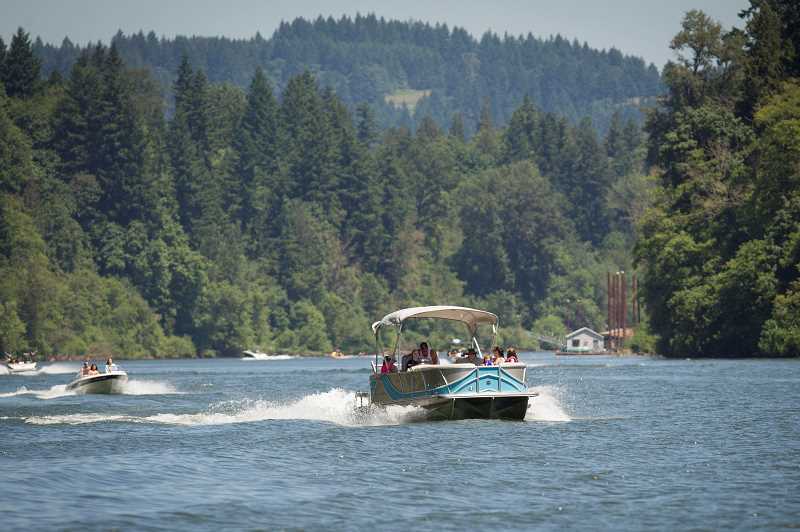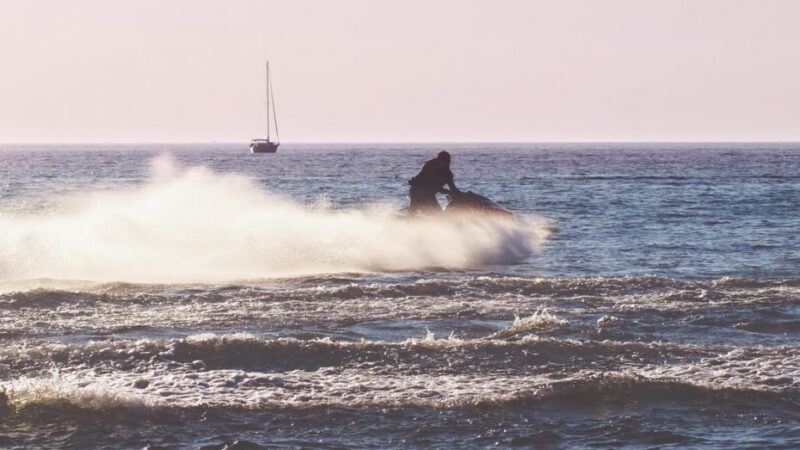Government agencies appear to have different views regarding effects on salmon, steelhead

Neal Maine, a past director of the North Coast Land Conservancy and retired marine biology teacher, compared the risks that endangered salmon and steelhead must endure to a stout warfront — attacks are coming in from all sides.
“It’s death by a thousand wounds versus a big blast,” he said.
While river habitat and biology experts say that a multitude of factors impact salmon and steelhead populations along the Willamette River, one activity has come under fire recently — wake sports like wakesurfing and wakeboarding.
Endangered-species protection has been used as one of the primary arguments for why these activities should be further restricted along the river and as justification for a potential lawsuit filed against state agencies.
But do wake sports really impact salmon and steelhead populations, and, if so, to what degree? While there is evidence to support the former, the latter depends on which government agency you ask.
“Our perspective is they have little to no effect,” said Oregon Department of Fish and Wildlife (ODFW) Deputy Fish Chief Bruce McIntosh.
However, others have a different view. “In NMFS’ (National Marine Fisheries Service, which is a division of the National Oceanic and Atmospheric Administration) experience, noise and wave actions are frequently a threat to juvenile salmon and steelhead,” wrote Kim Kratz, the NOAA assistant regional administrator in the West Coast Regional Office, in a letter to the Oregon State Marine Board.
Salmon, steelhead dwindling
Based on records of fish passage along the Willamette River since 1961, the ODFW counted a high of over 96,000 spring chinook salmon in 2004 and only 20,000 in 2019. Winter steelhead numbers neared 24,000 in the late 1980s before cratering to as low as 822 in 2017 (the population has since increased) and coho salmon have fallen from over 27,000 in 2008 to 3,500 by 2015. And the health of juvenile salmon was listed as very poor in the lower Willamette River, according to a recent EcoHealth report card.
Maine said that due to the vast riverscape that salmon travel — chinook salmon, for example, are born in freshwater, migrate to sea and then return to reproduce in freshwater — they can be affected by myriad factors.
“Any one event alone may not be a showstopper, but when you add upper stream, lower stream (factors), add those all together, they have some impact,” he said.
According to the ODFW Upper Willamette River Conservation and Recovery Plan for Chinook Salmon and Steelhead: “Scientists have estimated that prior to the arrival of Europeans, more than a million salmon and steelhead returned to spawn in Oregon’s rivers and streams in the Upper Willamette basin. Over the course of the last two centuries, the combined effects of fish harvest, hatchery fish interactions, flood control and hydropower operations, and habitat alterations have led to drastic declines in these populations.”
McIntosh said the main detriment to such populations are blockages to river passages caused by federal dams.
“These are depressed populations and, frankly, they’re not going to change all that much until we get passage at the federal dams,” Mcintosh said. “You’ve got anywhere from 95 to 100% of historical habitat blocked above those dams.”
He also mentioned sea lions eating steelhead and salmon at Willamette Falls as a major issue. The ODFW received federal clearance to kill some California sea lions there to reduce that effect.
Wake sports impact?
The question of the impact that wake sports have on endangered species like salmon and steelhead came to the fore when NMFS sent a letter (cited earlier in this article) to the Marine Board asking them to more strongly consider the impact that wake sports can have on such endangered species when creating new rules for the Newberg Pool portion of the river, which is roughly from Newberg to West Linn.
The board recently agreed to move forward with a proposal that would reduce the number of wake surfing zones from five to two, though it has yet to vote on whether to approve the changes.
The letter was strong in its conviction.
It stated: “Therefore, we expect that wake sports are likely to have a significant adverse impact on those listed species and their critical habitats by injuring and killing individual fish when, for example, the surge and wakes caused by artificial waves from passing boat and wake sport participants wash juvenile fish onto the shore, or otherwise modify or degrade PBFs (physical and biological features) in ways that injure or kill fish by significantly impairing their essential behavior patterns.”
To piggyback off the letter, Willamette Riverkeeper, a nonprofit river protection organization, threatened to sue the Marine Board and the Oregon Department of State Lands if they don’t bring forward policies to protect such species.
So what is its justification?
Stan Gregory, the emeritus professor of Fisheries at the Oregon State University Department of Fisheries & Wildlife, said that the waves produced by wake sports place a strain on habitats near the river shore such as young fish with limited swimming ability.
“In the summertime, you’re a young chinook salmon moving your way down the edge of the Willamette River, and you’re eating, and suddenly a wake that can be a foot to several feet high comes sweeping in and it would do several things: It would disrupt them, change their movements, change their locations and make them vulnerable to predators,” Gregory said.
He added that erosion allegedly caused by wake sports adversely affects aquatic insects that are a food source for young fish.
“We have large artificial waves impacting nearshore habitat,” said Travis Williams, the executive director of Willamette Riverkeeper. “Those areas are really productive, and yet those are areas being impacted by artificial waves.”
NMFS cited many studies in its letter to the Marine Board, some of which showed that recreational boating can adversely affect near-shore invertebrates (food for salmon and steelhead), that vessel-induced waves leave juvenile salmon stranded, and that turbidity erodes social organization among coho salmon, among other topics.
However, they didn’t list any studies that specifically looked at the impact of wake sports’ impacts and none took place on the Willamette River.
“I think that letter was interesting that it only singled out wake boats when what we’re dealing with is waves from power boats in general,” said Matt Radich, the president of Active Water Sports.
Radich would like to see more concrete evidence regarding the detrimental impacts of wake boats before any measures like banning wake surfing along most of the Willamette River (something Williams supports) are imposed.
“I want to work with facts, not opinions and anecdotal stories,” he said.
Gregory, on the other hand, thought that the burden of proof should fall more heavily on the side of protection than deregulation.
“Until we get the data, we have to be protective and precautionary of our actions, precautionary in protecting the public’s resource, and not causing harm to the resources and species of concern,” he said.
He added: “The burden of proof is for them to show they’re not having an effect; that’s my personal ethical perspective. It’s not a legal statement.”
Despite the claims made by NMFS and Willamette Riverkeeper, McIntosh said that in the department’s experience and research, wake boats do not significantly impact salmon and steelhead. The ODFW staffer said that during the peak time when wake sports activities are most popular, the summer months, those species already have completed migration and are more likely to be located in the portion of the Willamette River near the McKenzie and the Santiam tributaries, where the water is cooler and is less amenable to wake sports.
“It’s (the Newberg Pool) not a place they spend a lot of time making a living. (We) look at that and say the impacts are low,” McIntosh said.
NMFS declined to comment for this story. However, McIntosh said the difference in opinion about the wake sports issue between ODFW and NMFS could be a result of the different responsibilities of the two agencies.
ODFW is charged with monitoring the overall health and population of the river, while NMFS is more focused on mitigating any impacts to endangered species.
“Their opinion is there’s likely an effect on critical habitat and listed (species). The take (the harm, harassing or killingof an endangered species) of one fish has to be authorized (under the Endangered Species Act); that doesn’t mean it’s a population effect. it doesn’t mean it will make or break the survival of the species,” McIntosh said.
Williams acknowledged that wake sports might be just one factor in a list of activities affecting endangered fish. However, he believes larger boats with more power that have been developed in recent years are particularly harmful.
“What types of machines are we allowing in public spaces, and where do you draw the line in terms of impact on the environment?” Williams said.
He added: “If we’re working on fish passage at dams, habitat restoration, water quality, we don’t want another factor coming in to affect these populations.”
Will board consider
federal input?
When deciding to move forward with rules for the Newberg Pool, the Marine Board directed staff to consult
with NMFS to discuss their concern.
Josh Mulhollem, the Marine Board environmental policy and program manager, said the board has talked to the federal agency and encouraged it to participate in the process moving forward, but didn’t say what could tangibly come out of these conversations. The board may decide to pass the rules as-is without making changes based on the letter or it could restart the rulemaking process.
“Any input we get from NMFS or anyone else, they will factor heavily into the board’s decision, and ultimately it could potentially lead them to go a different direction. That would require a new drafting of rules and another comment process,” Mulhollem said.
Until this point, Williams said he’s been struck by the marine board’s lack of consideration for impacts to endangered species when considering rule changes.
Mulhollem, though, noted that one of the board’s tenets is to consider impacts to wildlife when assessing rules for the river.
“What that consideration looks like, it’s difficult to say,” he said.
You count on us to stay informed and we depend on you to fund our efforts. Quality local journalism takes time and money. Please support us to protect the future of community journalism.







Recent Comments